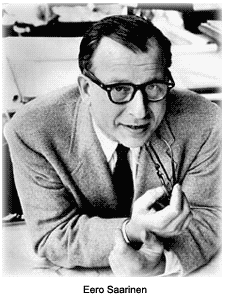Eero Saarinen, a naturalized citizen of the United States, is probably best remembered for his cutting-edge design of an arched gateway to the American West, on the banks of the Mississippi River. The 630-foot-high, graceful, tapered curve of stainless steel, the St. Louis Gateway Arch, is part of the Jefferson National Expansion Memorial, and is the tallest memorial in the U.S.
 Early Years
Early Years
Eero was born in Finland in 1910. His father, Eliel, a renowned architect in Europe, moved the family to the United States in 1923.
Eero studied art in Paris and at Yale University. His first love was sculpture. After a year in art school, however, he decided to follow in his father’s footsteps. His architecture often reflects the sculpture medium's influence.
Like Father...
If Eero were preordained to become an architect, he could not have been any luckier than to inherit his father’s genes. Eliel was at the leading edge of a new architectural style in Europe in the early 1900s, called Art Nouveau, a melding of several influences combined with a desire to let the creative juices flow where they would.
An example of that budding style was the Finnish pavilion at the World Fair of 1900, embodying a Finnish wooden architecture, British Gothic Revival, and Jugendstil, an architectural style, or decorative art similar to Art Nouveau. Saarinen's early style was later christened “Finnish National Romanticism,” which culminated in the Helsinki Railway Station, constructed between 1910 and 1914. Utilizing his artistic talents, he designed the Finnish markka banknotes in 1922.
In 1925, following the Saarinens' move to America, publisher and art patron, George Gough Booth, asked Eliel to design the campus of Cranbrook Educational Community. That facility was intended to be the American equivalent of the European Bauhaus, a combined architecture school, crafts school, and arts academy. It offers unique, academy-style learning where students in each department study directly under a resident artist.
Saarinen taught there and became president of the Cranbrook Academy of Art in 1932. Among his student collaborators were the Eames ("aims"), Charles and his wife, Ray, whose subsequent furniture design was influenced by Saarinen.
...Like Son
Eero studied for a time under his father at Cranbrook. He became a naturalized citizen in 1940, and in 1948, submitted the winning design for the St. Louis Arch, although it was not completed until the 1960s. The prize money was sent to his father by mistake.
 Eero developed a remarkable artistic range that drew from color, form, and materials. He showed a marked inclination toward innovative structures and sculptural forms, but not at the cost of practical realities. He moved easily between the International style and Expressionism, utilizing a wide variety of curves, cornices, and cantilevers.
Eero developed a remarkable artistic range that drew from color, form, and materials. He showed a marked inclination toward innovative structures and sculptural forms, but not at the cost of practical realities. He moved easily between the International style and Expressionism, utilizing a wide variety of curves, cornices, and cantilevers.
The International style used by Eero Saarinen was a major architectural trend of the 1920s and 1930s. The basic design principles are identical with those of Modernism, but the term usually refers to the buildings and architects of the formative decades of Modernism, before World War II. Eero’s grasp of the style's subtleties helped him to become the most important American architect of the mid-20th century.
Eero Saarinen was the chief architect, or top collaborator, for some of the most critically acclaimed structures in the U.S.:
Saarinen died of a brain tumor at the age of 51, in Ann Arbor, Michigan.
“This interdenominational chapel, built on a small, hemmed-in site, masterfully achieves an atmosphere conducive to meditation. Reached by a glassed-in walkway that crosses a tiny moat, on the outside it’s a windowless, brick-faced cylinder; inside, its brick walls undulate gently and natural light comes in indirectly from the sides and above.”